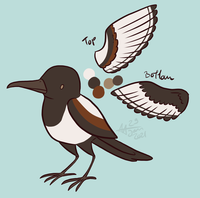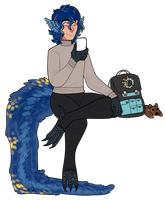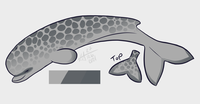Profile
Alocret Sparrows [LINK]
These small birds are a common sight on Plystre's parks and wildernesses. Observed behaviours are very skittish, flying away at the first sight of any potential threats but those closer to urban areas are calmer with the crowds, they will also try and steal small and shiny items of any kind for their small nests hidden all over the place to make them more enticing for potential mates, most frequently small parts from dockyards and dry-docks or pens and bottle caps from the universities.
Bijmímut Owls [Link]
Commonly referred to as 'Flying Radar Dishes' and found within Plystre's plains and prairies, the Bijmímut (Roughly translated to "Jewellery") are a species of predatory bird that carry an both a cone-like face and a considerable series of head feathers that can rise, fall, fan out and close up to acutely find even the most quiet noise from miles around, and hunt down the ones making them. During windy conditions, they are able to safely glide in place for a considerably amount of time. Their main weapons an incredibly sharp set of talons, with most people who keep Bijmímut having to wear armoured gloves to avoid damage. The reasoning behind their name is very simple; Their feathers are colourful and reflective, much like pieces of jewellery. It is also well-known that they are monogamous, meaning they that mate for life. While there are many depictions and examples to mention from common and harder to find pieces of media, perhaps the most famous of the Bijmímut Owl is "Athena", the beloved pet of fictional Interstellar Detective Harker from the show and comic series "Finders Killers", and who's name is a reference to ancient human mythology.
Karrikei Frog [LINK]
One of many frogs found on Plystre, the Karrikei (Named after a kind of local biscuit that is rarely made anymore) are primarily aquatic creatures. These frogs will normally eat scraps of fruit and flesh purposefully left behind by the Syreami Fish after it knocks them into the water, providing a mutualistic relationship. These frogs were originally mistaken for another species until several distinctions were made, such as a lack of toxins and it's considerably larger size. As an odd cultural effect of how the Karrikei Frog functions around the Syrearmi Fish, a large number of support-focusing companies and vessals have adopted the name 'Karrikei'.
Liosyt Moths [LINK]
A well-loved nocturnal creature, the Liosyt (Roughly translated to "Light") are small flying insects that typically stay in large groups for protection and reproduction. What makes them curious is a natural generation of chemicals from their environment that results in bioluminescence within relatively clear abdomens. When approached by an unfamiliar movement, the moths become noticeably brighter, to the point of Plystre's authorities strongly advising against walking through "Liosyt Moth Clouds" for risk of temporary blindness. However, despite the minimal risk, Liosyt Moth Clouds are a cultural icon, with a number of shops closing later if they're able to see these clouds when it's dark enough in spring and summer seasons.
Píkittaa Otters [LINK]
Officially' declared the cutest animal of Plystre by relative bodies, the Píkittaa (Roughly translated to "Embitter") are semiaquatic mammals that mostly float around and eat, being considerably passive. Upon first glance, it's odd lack of natural predators may just show how beloved and friendly they are, with nothing wanting to hurt them. But in reality, the Píkittaa focus on eating and filtering the poisons and venoms from the many Plants, Fish, and Insects they prey upon, storing them internally. This has lead to local fauna having learnt to not try to eat them or else become afflicted with some of the most lethal concoctions known to naturally formulate. They used to be known as "Flafrinen-Aloútsi" (Roughly translated to "Fluffy Log") before interstellar naming conventions arrived to assist with easier clarifications, however the process caused backlash as many inhabitants, both native and foreign, preferred the previous name. This is still a hotly contested issue.
Relíkti Stepping Fish [LINK]
One of the oldest and most bizarre creatures of Plystre, the Relíkti (Roughly translated to "Relic") are creatures that carry considerably durable exoskeletons and an array of acute whiskers. Despite it's large and usually threatening disposition, they are supremely passive as they feast mostly on aquatic plants such as kelp, or small animals such as crustaceans. The lungs and gills of the creature, combined with it's limbs, allow it to safely walk on land to sites used to sleep and nest nearby the water, though Relíkti that cannot find their way to the water can survive on land. Findings within archaeological excavations on the planet suggest that these creatures haven't evolved in nearly thirty seven million years, with signs of some of the earliest Plystrian cultures being younger, and items such as shields, weapons, certain utility tools, and other items being made out of the Relíkti's bones, both internal and external. However, many sources suggest that many practices have also been used with them even to today, with a good example being the locating of hidden items as their whiskers can easily detect subterranean delicacies and sometimes illegal substances.
Syreami Fish [LINK]
A native to Plystre's waters, the Syreami (Old local word for "Cutter") are a species of fish that predate on fruit and small animals, frequently those that are knocked into the water by the Karrikei Frog, where after eating it will leave some food behind for the frog to eat in a mutualistic relationship. Furthermore, the pairing with Karrikei Frogs extend to common Plystrian Media, with a number of shows and animations frequently anthropomorphising the pairing, with extensions to non-native cultural ideas, such as those who design costumes themed around animals.
Xéfrenja Rodents [LINK]
A common and frequently adorable sight on Plystre's mountains, the Xéfrenja (Roughly translated to "Frenzied") are furred animals, with their name being attributed to many things, such as their small bodies and aggressively territorial nature to the fact that oversized glands store vast amounts of a unique adrenaline that afflict a range of psychoactive effects. Historical records ranging from over 500 to as early as 50,000 years ago have heavily suggested that select warriors of various Plystrian clans used to eat them until becoming so heavily intoxicated that they became wild, uncontrollable, and dangerous. In modern times however, these creatures have become nothing more then an oddity, scouring the mountains for food underneath snow and rock, while occasionally harassing mountain climbers and skiers who dare incur their micro-sized wraith. The Plystrian Natural Preservation Society often sells plush versions to help fund projects and methods to ensure the animals continue to survive in their natural habitats, regardless of if their staff is unwelcomed by the critters.
Zréfonaluu Dolphins [LINK]
Usually around the Aquatic Harbours around Plystre's oceans, as well as lakes and rivers that are large enough, the Zréfonaluu (Roughly translated to "Returner") are a social species of aquatic mammals that have found an odd success within these areas, they usually find themselves entertaining tourists and locals for food. Several subspecies are known to exist thanks to their climates or environmental requirements, but one of their more interesting abilities is to spit pressurised water out of specialised glands in their mouth, originally believed to be used for disorientating aquatic prey or knocking food into the water for consumption, as well as moving items out of their environment to create a 'stage' for mating purposes. However, through one means or another, those closest to Urban areas tend to use this for a different reason, hinted to by their old name of "Drothoppo Daienha" (Roughly translated to "Drunkard Fiend"). This name comes from the fact that they tend to throw items back out of their waters, such as dropped technology or careless litter, usually into the face of the one who was responsible. Numerous documents suggest that after vehicles have crashed into their territory, they will push those involved back to the surface before throwing parts of the vehicle that came loose.
Fálalas-Dóeeihä Birds [LINK]
Massive avian creatures that are long extinct, the Fálalas-Dóeeihä (Roughly translated to "Whale-Spear") were predative and territorial creatures that hunted surfacing whales with incredibly sharp beaks and strong necks. It is speculated by the structure of fossils that they were capable of hovering while they hunted and dragged dead whales back to coastal regions where they nested. The likely cause behind the Fálalas-Dóeeihä's extinction was a loss of viable food, as Whales had slowly migrated and adapted to dive for longer periods of time. There are five known complete fossils, two within Plystre's Natural History Museums and the other three gifted to separate species as part of archaeological exchanges.









Comments